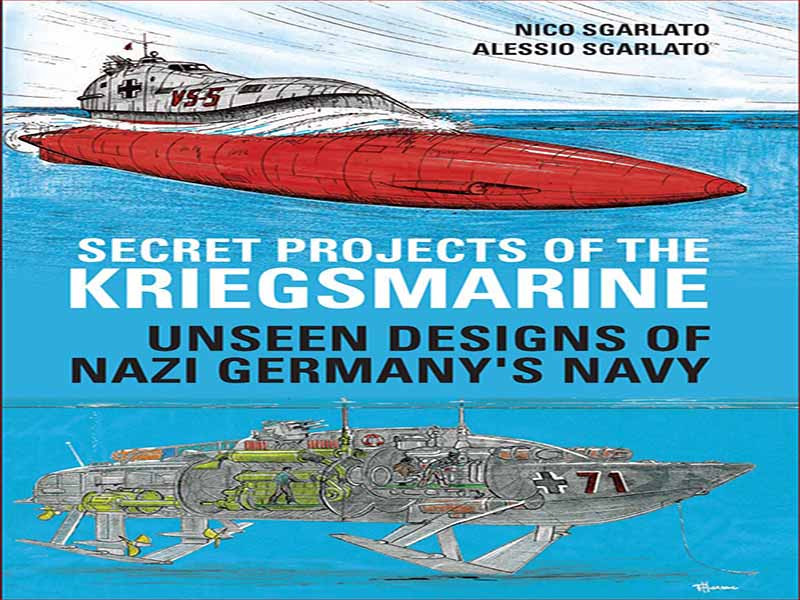- عنوان کتاب: SECRET PROJECTS OF THE KRIEGSMARINE / UNSEEN DESIGNS OF NAZI GERMANY’S NAVY
- نویسنده/انتشارات: Alessio-Sgarlato–Nico-Sgarlato
- حوزه: نیروی دریایی, تاریخ جنگ
- سال انتشار: 2022
- تعداد صفحه: 546
- زبان اصلی: انگلیسی
- نوع فایل: pdf
- حجم فایل: 10.1 مگابایت
غیرقابل انکار است که در تاریخ ملت ها نقاط عطف بسیار مشخصی وجود دارد که اقدامات آینده و در نتیجه سرنوشت آنها را شکل می دهد. در مورد آلمان، سلسله وقایعی که منجر به وقوع جنگ جهانی دوم در اروپا شد، احتمالاً میتوانست از دو جنبه اساسی تحریک شود: پیامدهای معاهده ورسای که پس از شکست در جنگ جهانی اول، محدودیتهای شدیدی برای فعالیتهای نظامی و ثانیاً، تمایل طبیعی آلمان به پیچیدگیهای فنی قرار داد که عموماً از میانگین «وضعیت هنر» در سایر کشورهای صنعتی برتر بود. بنابراین، برای مثال واضح ترین، ممنوعیت ساخت هواپیماهای نظامی متعارف منجر به علاقه بیشتر به آموزش با گلایدر شد که منجر به دانش برتر در زمینه آیرودینامیک و جستجوی همراه برای ابزارهای غیر سنتی پیشران شد. می توان مشاهده کرد که این نتایج در زمینه موشک ها و هواپیماهای جت به اوج می رسد. با این حال، وضوح بینش همیشه با چنین دستاوردهایی در کشوری همراه نبود که «سیاست شخصیت» غالباً بر حس نظامی غلبه داشت. به عنوان مثال، علیرغم پتانسیل عظیم صنعتی که امکان تولید هواپیماهای جنگنده و خودروهای زرهی را فراهم می کرد، مرگ نابهنگام قبل از جنگ یک تاکتیک دان لوفت وافه (ژنرال والتر وور) باعث شد که ماشین جنگی آلمان به نقش بالقوه توجه چندانی نداشته باشد. بمب افکن های سنگین استراتژیک؛ هواپیماهایی مانند B-17، B-24 و B-29 آمریکایی یا Avro Lancaster بریتانیا که همگی نقش اساسی در پیروزی متفقین داشتند. آلمان هرگز دارای نیروی دریایی قابل مقایسه با نیروی دریایی ژاپن، بریتانیا، ایتالیا و ایالات متحده نبود. هرگز نمیتوان به هدف برابری با نیروی دریایی فرانسه دست یافت و علیرغم باورهای اشتباه اولیه مبنی بر اینکه «جنگ رزمناو» با استفاده از کشتیهای سرمایهای علیه خطوط تدارکاتی و تجاری بریتانیا برای کریگزمارین امکانپذیر است، استفاده ناامیدکننده از کشتیهای جنگی و رزمناوهای سنگین. آلمانیها در نهایت به کریگزمارین منجر شدند تا شانس پیروزی را در قایقهای زیربنایی داشته باشند. این واحدهای زیر آب، یوبوت های معروف، به سطح معینی از موفقیت، به ویژه در برابر ترافیک تجاری متفقین و همچنین به طور دوره ای در برابر کشتی های جنگی بریتانیا، به ویژه در دریای مدیترانه، دست یافتند. اگرچه سرویس U-boat آنقدر از منابع محروم بود که هرگز واقعاً شانسی برای رسیدن به ارتفاعات بدست آمده توسط نیاکان خود در جنگ قبلی نداشت، موفقیت U-boat که به دست آمده بود منجر به مطالعات سایر انواع زیر آب شد. وسایل نقلیه، پس از آنچه قبلاً توسط شرکای آلمانی Axis ژاپن و ایتالیا انجام شده بود.
It is undeniable that in the history of nations there are very specific turning points that shape their future actions and therefore their destiny. In the case of Germany, the series of events that led to the outbreak of the Second World War in Europe could arguably have been stimulated by two fundamental aspects: the consequences of the Treaty of Versailles which, following defeat during the First World War, had placed severe limits on military activities and, secondly, the natural German inclination for technological sophistication that was generally superior to the average ‘state of the art’ within other industrialised countries. Thus, to take perhaps the most obvious example, the prohibition of building conventional military aircraft led to greater interest in training with gliders that resulted in superior knowledge in the field of aerodynamics and an accompanying search for non-traditional means of propulsion. These could be seen to culminate in the cutting-edge results in the fields of rockets and jet aircraft. However, clarity of vision did not always accompany such achievements in a nation where ‘personality politics’ frequently overruled military sense. For example, despite the enormous industrial potential that allowed high levels of production of fighter planes and armoured vehicles, the untimely pre-war death of a single Luftwaffe tactician (Generalleutnant Walther Wever) resulted in the German war machine paying scant attention to the potential role of strategic heavy bombers; aircraft such as the American B- 17, B-24 and B-29 or the British Avro Lancaster, all of which played a fundamental part in the victory of the Allies. Germany never possessed a navy comparable in size to those of Japan, Great Britain, Italy and the United States. An aim for parity with the French Navy could never be achieved and, despite early mistaken beliefs that ‘cruiser warfare’ by means of capital ships against British supply and trade lines would be possible for the Kriegsmarine, the disappointing use of what battleships and heavy cruisers the Germans did possess led, eventually, to the Kriegsmarine staking any chance of victory on U-boats. These underwater units, the famous U-boats, achieved a certain level of success, particularly against Allied merchant traffic but also periodically against British warships, perhaps most notably in the Mediterranean Sea. Though the U-boat service had been starved of resources so long that it never truly stood a chance of reaching the heights achieved by its forebears of the previous war, the U-boat success that had been achieved led to studies of other types of underwater vehicles, trailing in the wake of what had already been done by Germany’s Axis partners Japan and Italy.
این کتاب را میتوانید از لینک زیر بصورت رایگان دانلود کنید:
Download: SECRET PROJECTS OF THE KRIEGSMARINE / UNSEEN DESIGNS OF NAZI GERMANY’S NAVY



































نظرات کاربران